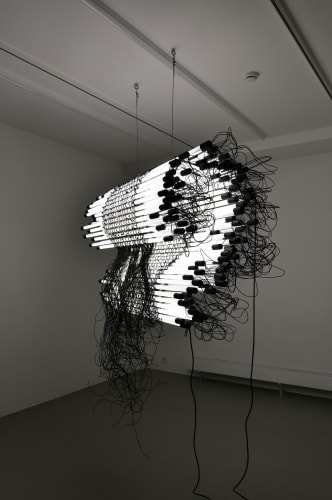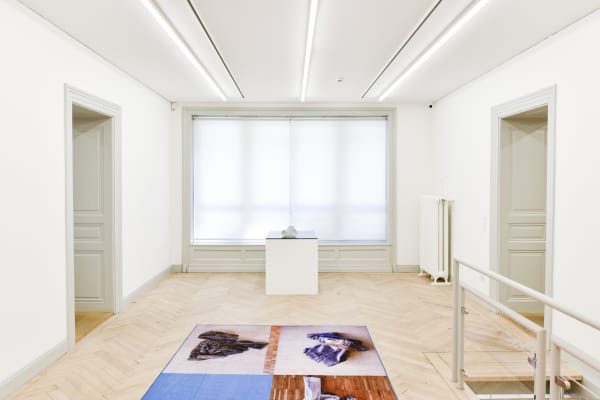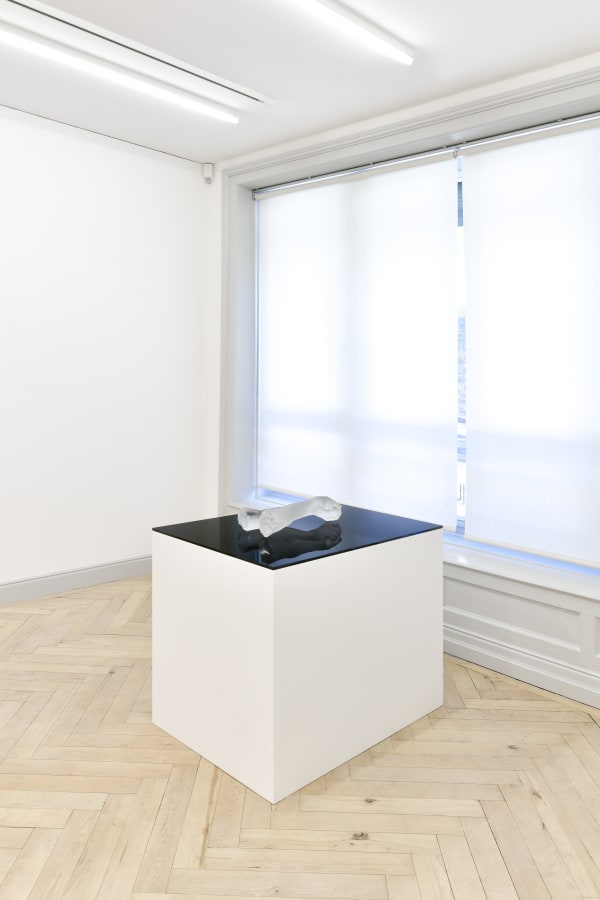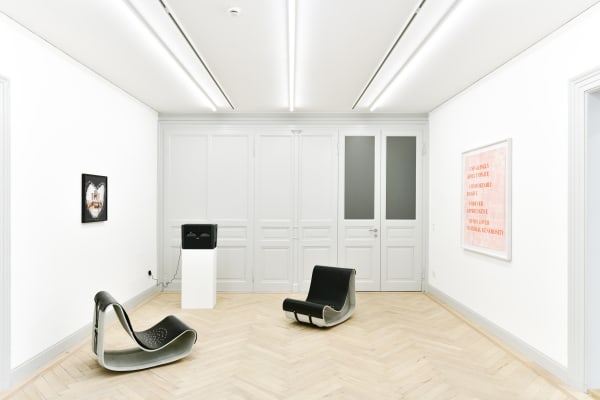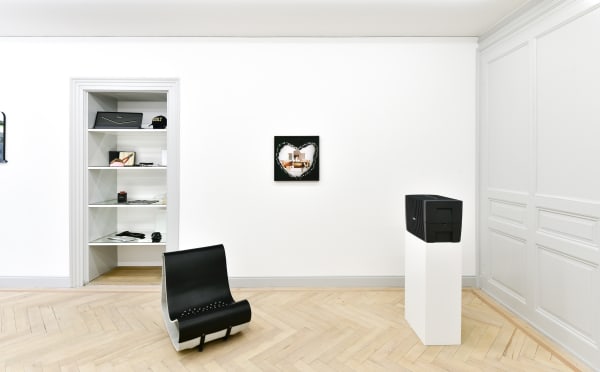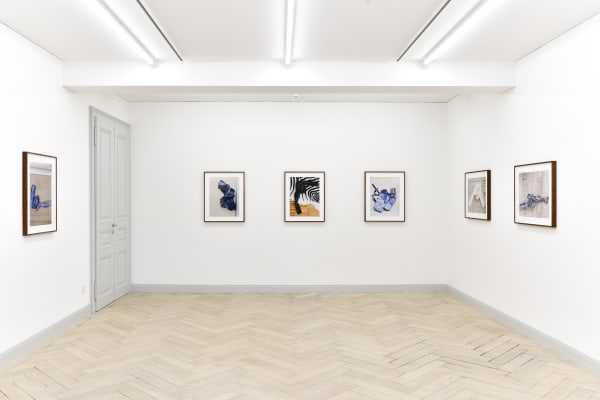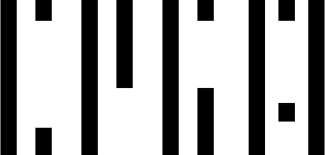Monica Bonvicini: No RestGalerie Peter Kilchmann, Rämistrasse, Zurich
Galerie Peter Kilchmann is pleased to announce the solo show No Rest by Monica Bonvicini at our Rämistrasse dependance. The exhibition will present new and existing works in a wide range of media, including sculpture, photography, works on paper and installations. Reacting to the intimate apartment character of the new gallery space, the show plays with elements of design.
April 24 - June 13, 2021
-
 Monica BonviciniBent on Going, 2019LED tubes, aluminum, electrical wire, plastic, cable100 x 200 x 58 cm (39.4 x 78.7 x 22.8 in.)Unique
Monica BonviciniBent on Going, 2019LED tubes, aluminum, electrical wire, plastic, cable100 x 200 x 58 cm (39.4 x 78.7 x 22.8 in.)Unique -
 Monica BonviciniSame Old Shit, 2018Black mirror, MDF90 x 80 cm (35.4 x 31.5 in.)Ed. 3/5 (+ 2 AP)
Monica BonviciniSame Old Shit, 2018Black mirror, MDF90 x 80 cm (35.4 x 31.5 in.)Ed. 3/5 (+ 2 AP) -
 Monica BonviciniSmall Pendant (2), 2021Glass, cable, aluminum cast26 x 39 x 6 cm, allover
Monica BonviciniSmall Pendant (2), 2021Glass, cable, aluminum cast26 x 39 x 6 cm, allover
9.5 x 39 x 4 cm, aluminium castUnique -
 Monica BonviciniNo Rest #3, 2021Digital print on paper, mounted on dibond76 x 61 cm (29.9 x 24.0 in.), framedEd. 1/5 (+ 2 AP)
Monica BonviciniNo Rest #3, 2021Digital print on paper, mounted on dibond76 x 61 cm (29.9 x 24.0 in.), framedEd. 1/5 (+ 2 AP) -
 Monica BonviciniNo Rest #4, 2021Digital print on paper, mounted on dibond76 x 61 cm (29.9 x 24.0 in.), framedEd. 1/5 (+ 2 AP)
Monica BonviciniNo Rest #4, 2021Digital print on paper, mounted on dibond76 x 61 cm (29.9 x 24.0 in.), framedEd. 1/5 (+ 2 AP) -
 Monica BonviciniNo Rest #6, 2021Digital print on paper, mounted on dibond76 x 61 cm (29.9 x 24.0 in.), framedEd. 1/5 (+ 2 AP)
Monica BonviciniNo Rest #6, 2021Digital print on paper, mounted on dibond76 x 61 cm (29.9 x 24.0 in.), framedEd. 1/5 (+ 2 AP) -
 Monica BonviciniAgainst Your Skin, 2020Spray paint on Fabriano paper100 x 75 cm (39.4 x 29.5 in.)
Monica BonviciniAgainst Your Skin, 2020Spray paint on Fabriano paper100 x 75 cm (39.4 x 29.5 in.)
115 x 91 cm (45.3 x 35.8 in.), framed -
 Monica BonviciniLover's Material Rosé, 2020Spray paint on Fabriano paper107 x 100 cm (42.1 x 39.4 in.)
Monica BonviciniLover's Material Rosé, 2020Spray paint on Fabriano paper107 x 100 cm (42.1 x 39.4 in.)
122.5 x 115.5 cm (48.2 x 45.5 in.), framed -
 Monica BonviciniNever Tire / Black, 2020Spray paint on Fabriano paper153 x 103 cm (60.2 x 40.6 in.)
Monica BonviciniNever Tire / Black, 2020Spray paint on Fabriano paper153 x 103 cm (60.2 x 40.6 in.)
165 x 115.5 cm (65.0 x 45.5 in.), framed -
 Monica BonviciniUp in Arms, 2021Murano glass, dark grey glass plate, pedestalObject: 10 x 44 x 22.5 cm
Monica BonviciniUp in Arms, 2021Murano glass, dark grey glass plate, pedestalObject: 10 x 44 x 22.5 cm
All-over: 88 x 100 x 70 cm -
 Monica BonviciniLittle liar, 2021Spray paint on digital print on Rauch Wall fleece51.2 x 51.2 cm (20.2 x 20.2 in.)
Monica BonviciniLittle liar, 2021Spray paint on digital print on Rauch Wall fleece51.2 x 51.2 cm (20.2 x 20.2 in.)
51.2 x 51.2 cm (20.2 x 20.2 in.), framedUnique -
 Monica BonviciniBreach of Decor (red pepper), 2020Printed carpet180 x 240 cm (70.9 x 94.5 in.)Ed. 3/5 (+ 2 AP)
Monica BonviciniBreach of Decor (red pepper), 2020Printed carpet180 x 240 cm (70.9 x 94.5 in.)Ed. 3/5 (+ 2 AP)
